Taiwan Integrated Circuits Market Size
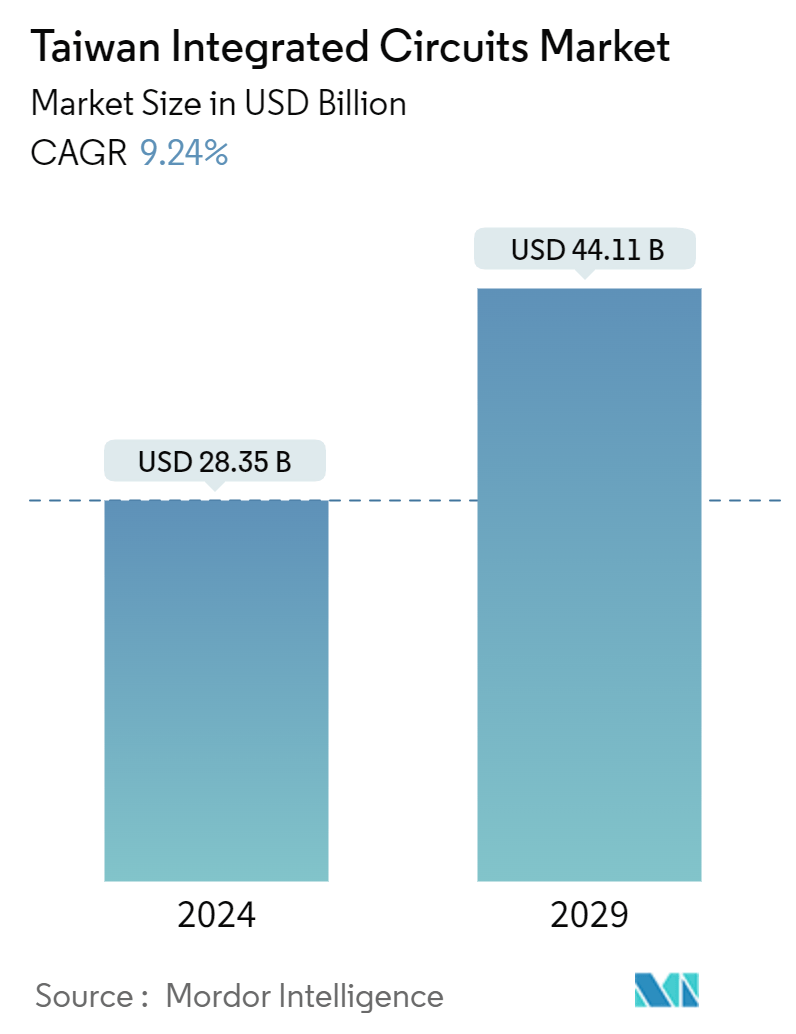
| Study Period | 2018 - 2029 |
| Base Year For Estimation | 2023 |
| Market Size (2024) | USD 28.35 Billion |
| Market Size (2029) | USD 44.11 Billion |
| CAGR (2024 - 2029) | 9.24 % |
| Market Concentration | Low |
Major Players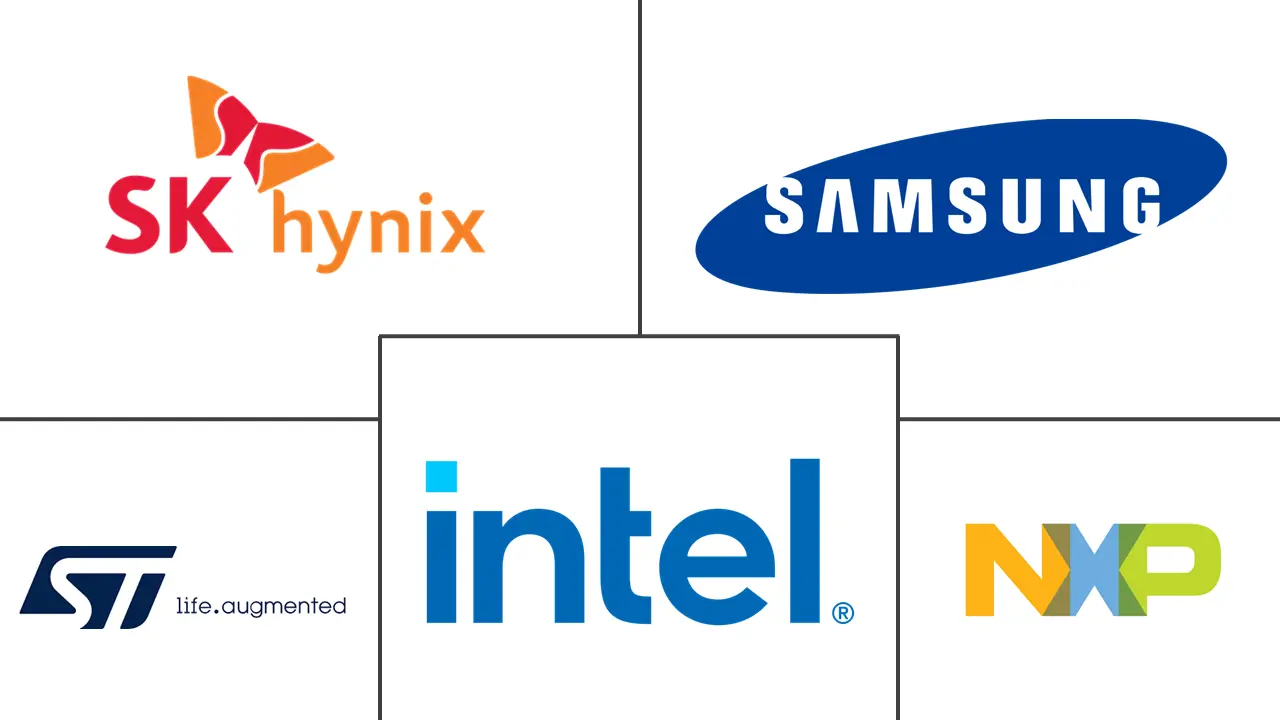
*Disclaimer: Major Players sorted in no particular order |
Taiwan Integrated Circuits Market Analysis
The Taiwan Integrated Circuits Market size is estimated at USD 28.35 billion in 2024, and is expected to reach USD 44.11 billion by 2029, growing at a CAGR of 9.24% during the forecast period (2024-2029).
- An integrated circuit (IC), often called a microchip, is a compact electronic device that combines interconnected components such as transistors, resistors, and capacitors onto a single piece of semiconductor material, typically silicon.
- Due to their robust design, ICs are generally more reliable than discrete circuits. The encapsulation of components within a single chip protects them from environmental factors like moisture and dust, which can lead to circuit failure. Additionally, fewer interconnections are required in ICs, minimizing the risk of solder joint failures and improving overall durability. This reliability is crucial in critical applications, such as medical devices, automotive electronics, and aerospace systems, where failure can have severe consequences.
- ICs can perform complex functions that would require multiple discrete components. For instance, a microcontroller IC can integrate processor, memory, and input/output interfaces on a single chip, allowing for sophisticated control systems in various applications. This integration enables the development of multifunctional devices, such as smartphones, which combine communication, computing, and multimedia capabilities.
- One of the primary drivers of the integrated circuit market in Taiwan is the rapid pace of technological advancements. Innovations in semiconductor technology, including miniaturization, increased efficiency, and enhanced performance, have propelled the demand for ICs.
- The continuous evolution of technologies such as machine learning (ML), artificial intelligence (AI), Internet of Things (IoT), and 5G connectivity has created a surge in the need for advanced integrated circuits capable of handling complex computations and high-speed data transmission. Taiwan's semiconductor manufacturers, including industry giants like TSMC (Taiwan Semiconductor Manufacturing Company), are at the forefront of these advancements, developing advanced processes and products that cater to a global market.
- The Taiwanese government has implemented several policies to boost the semiconductor industry, recognizing its importance to the national economy. Initiatives such as tax incentives, subsidies for R&D, and investments in educational programs to develop a skilled workforce are significant market drivers. The government's "Taiwan Semiconductor Industry Development Plan" aims to enhance the global competitiveness of Taiwan's semiconductor companies. To that extent, the National Development Fund announced that between 2021 and 2025, companies in Taiwan planned USD 107 billion in investments to grow the semiconductor industry.
- However, developing advanced ICs requires substantial investment in technology and skilled personnel, which can be prohibitive, particularly for smaller companies. Further, rapid technological advancements can lead to obsolescence. Companies must continuously innovate to meet evolving consumer demands and competitive pressures. This fast-paced environment can strain resources and limit market entry for new players. Moreover, supply chain vulnerabilities, such as semiconductor shortages, can disrupt production and increase costs.
Taiwan Integrated Circuits Market Trends
The Logic Segment is Anticipated to Hold a Major Market Share
- A logic integrated circuit is a type of semiconductor device that combines multiple logic gates into a single chip. These circuits are fundamental components in digital electronics, enabling binary data processing through logical operations. Logic ICs are critical components in modern electronics.
- Logic ICs are essential for performing arithmetic operations, data processing, and control functions at the core of computers and microprocessors. Logic gates form the basis of the central processing unit (CPU), executing instructions through binary operations. With the increasing complexity of computing tasks, advanced ICs like microcontrollers and microprocessors integrate millions of logic gates, enabling high-speed computations and multitasking capabilities.
- Logic ICs are pivotal in digital communication systems, where they facilitate the encoding, decoding, and modulation of signals. They enable error detection and correction algorithms, allowing reliable data transmission over various mediums such as fiber optics, wireless networks, and satellite systems. Digital signal processors (DSPs), which are specialised logic ICs, are extensively used in audio and video compression, speech recognition, and telecommunications.
- Consumer electronics, including televisions, smartphones, and gaming consoles, rely heavily on logic ICs for functionality. Logic gates control various features, such as user interfaces, audio and video processing, and connectivity options. For instance, modern smart TVs utilize logic ICs for smart features like internet streaming, app management, and voice control.
- The increase in Taiwan's export of integrated circuits will likely aid the demand for the studied market. For instance, according to Taiwan customs, in 2023, the value of integrated circuit exports from Taiwan amounted to USD 0.16 trillion. The region was one of the top chip producers in the world.
- Moreover, Taiwan's automotive industry is poised to bolster the market under examination. In recent years, the Taiwanese government unveiled mandates stipulating that all new passenger cars and scooters should be zero-emission by 2040, aiming to significantly reduce the nation's carbon footprint and promote sustainable transportation. Additionally, the government targets a 30% penetration rate for new electric cars by 2030, escalating to 60% by 2035. Simultaneously, it aims for new electric scooters to constitute 70% of the market by 2035.
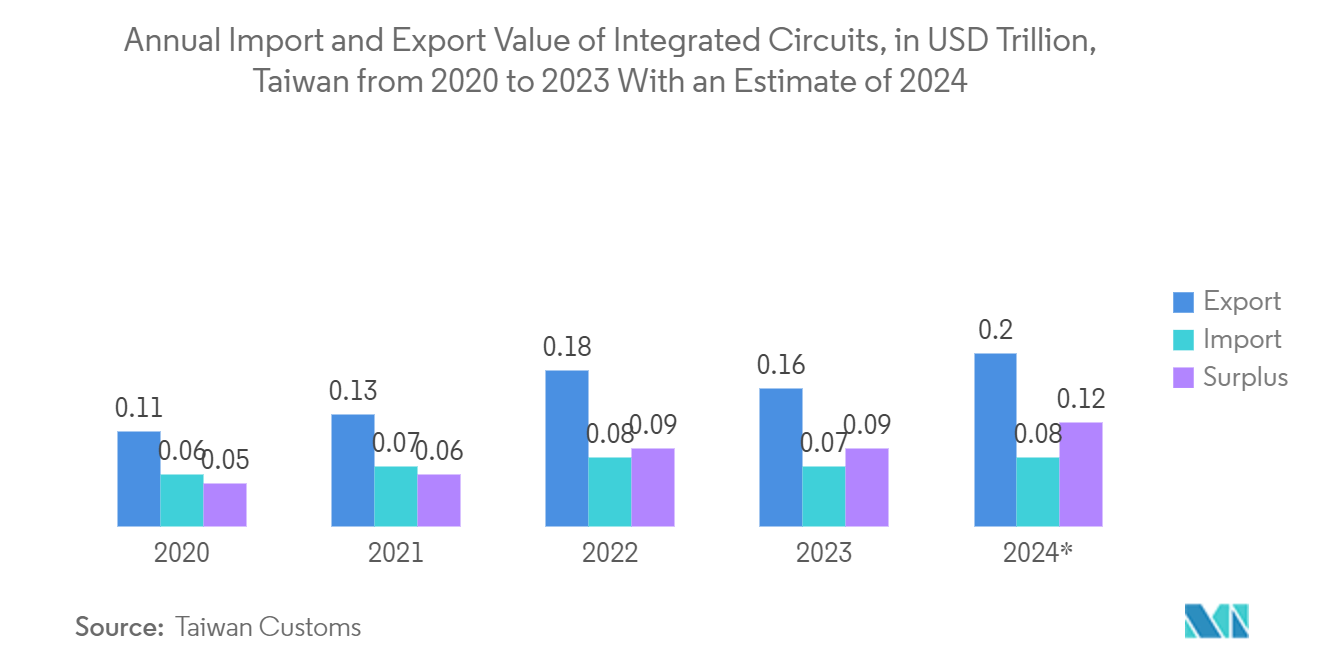
The IT and Telecommunications Sector is Anticipated to Drive the Demand for the Studied Market
- In IT, integrated circuits (ICs) are central to the development of microprocessors and microcontrollers. Microprocessors, which serve as the brains of computers, are built on IC technology. They execute instructions and process data, enabling complex computing tasks. The evolution of microprocessors, from early 8-bit designs to today's powerful multi-core processors, has significantly enhanced computing performance, allowing for faster data processing, improved graphics, and enhanced multitasking capabilities.
- The communication industry relies heavily on integrated circuits (ICs) to enable connectivity and data transfer. From basic telecommunication systems to complex data networks, ICs are integral to facilitating communication protocols and standards.
- Integrated circuits play a vital role in telecommunications signal processing, modulation, and demodulation. For instance, ICs are used in mobile phones to manage radio frequency (RF) signals, enabling wireless communication over cellular networks. They allow for features like error correction, voice encoding, and data compression, enhancing the quality and efficiency of communication.
- The rollout of 5G networks necessitates the development of specialized integrated circuits that can handle higher frequencies and increased data rates. ICs designed for 5G applications enable faster mobile broadband, low-latency communication, and the support of many connected devices. According to forecasts by GSMA, over 50% of all mobile internet connections in the country are expected to be based on 5G technology by 2025. Thus, the growth of 5G technology significantly drives the demand for the studied market.
- The expansion of cloud services in Taiwan, driven by domestic companies and global tech giants setting up data centers, increases the demand for integrated circuits. As data centers in Taiwan become more sophisticated and densely packed to maximize efficiency and performance, the demand for high-performance ICs rises. In September 2023, Cloudscene reported 20 data centers in Taiwan.
- The rise in data center investments also aids the growth of the studied market in Taiwan. For instance, in March 2024, Vantage obtained a loan of USD 64 million for its data center project in Taiwan. Taiwanese banks provided the funds, which will be utilized to construct the company's initial facility in Taipei, TPE11. Vantage secured the loan from CTBC Bank and Cathay United Bank. This transaction represents the first time a data center operator in Taiwan secured financing for a hyperscale data center.
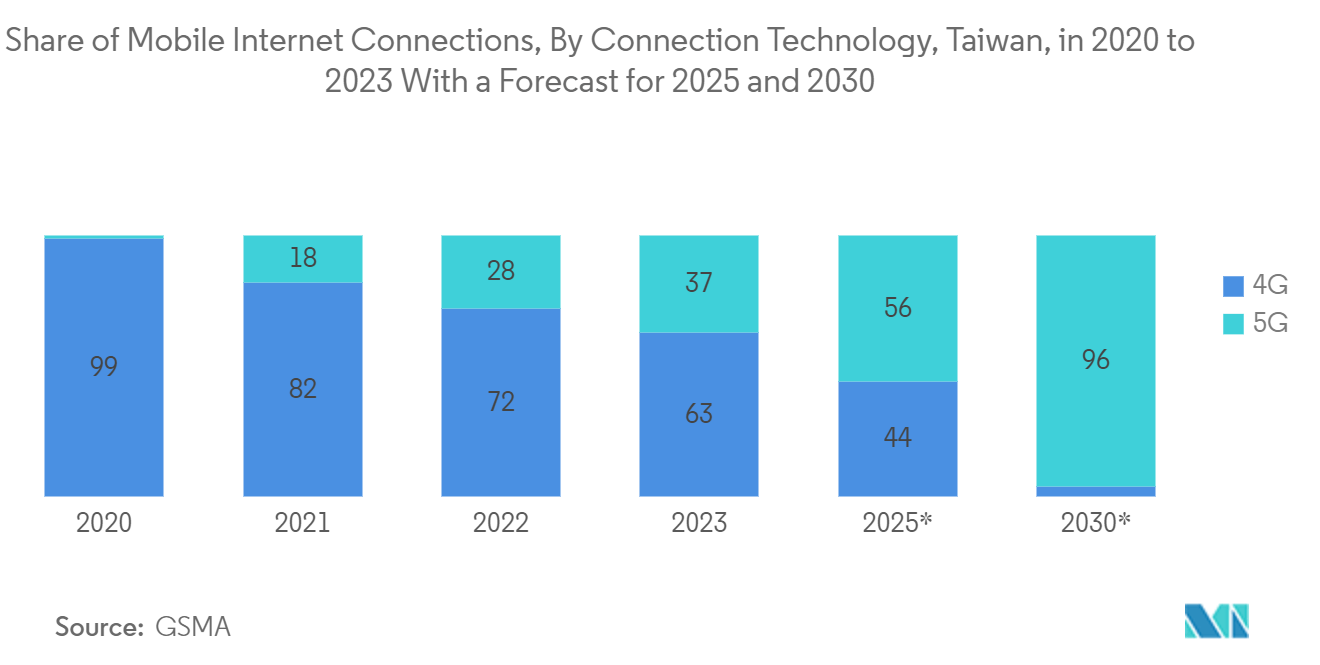
Taiwan Integrated Circuits Industry Overview
The Taiwan integrated circuits market is fragmented, with several major players, such as SK Hynix Inc., Intel Corporation, STMicroelectronics N.V., NXP Semiconductors N.V., Samsung Electronics Co Ltd., etc. These market players are striving to innovate new products through extensive investments in R&D, collaborations, and mergers to cater to consumers' evolving demands.
- In March 2024, STMicroelectronics announced the launch of its ultra-low-power STM32U0 Arm Cortex-M0+ microcontroller family, running up to 56 MHz.This family reduces energy consumption by up to 50% compared to previous product generations, such as STM32C0 or STM32L0, while targeting SESIP Level 3, PSA-Certified Level 1, and NIST certifications.
- In January 2024, NXP announced the launch of a series of Arm Cortex–M33–based general-purpose microcontrollers (MCUs). Targeting a broad range of industrial sensing, motor control, and IoT applications, the NXP MCX A14x and NXP MCX A15x devices feature a low-power peripheral set, a motor control subsystem, and integrated MIPI-I3C, I2C, and SPI interfaces.
Taiwan Integrated Circuits Market Leaders
-
STMicroelectronics N.V.
-
NXP Semiconductors N.V.
-
Intel Corporation
-
Samsung Electronics Co Ltd
-
SK Hynix Inc.
*Disclaimer: Major Players sorted in no particular order
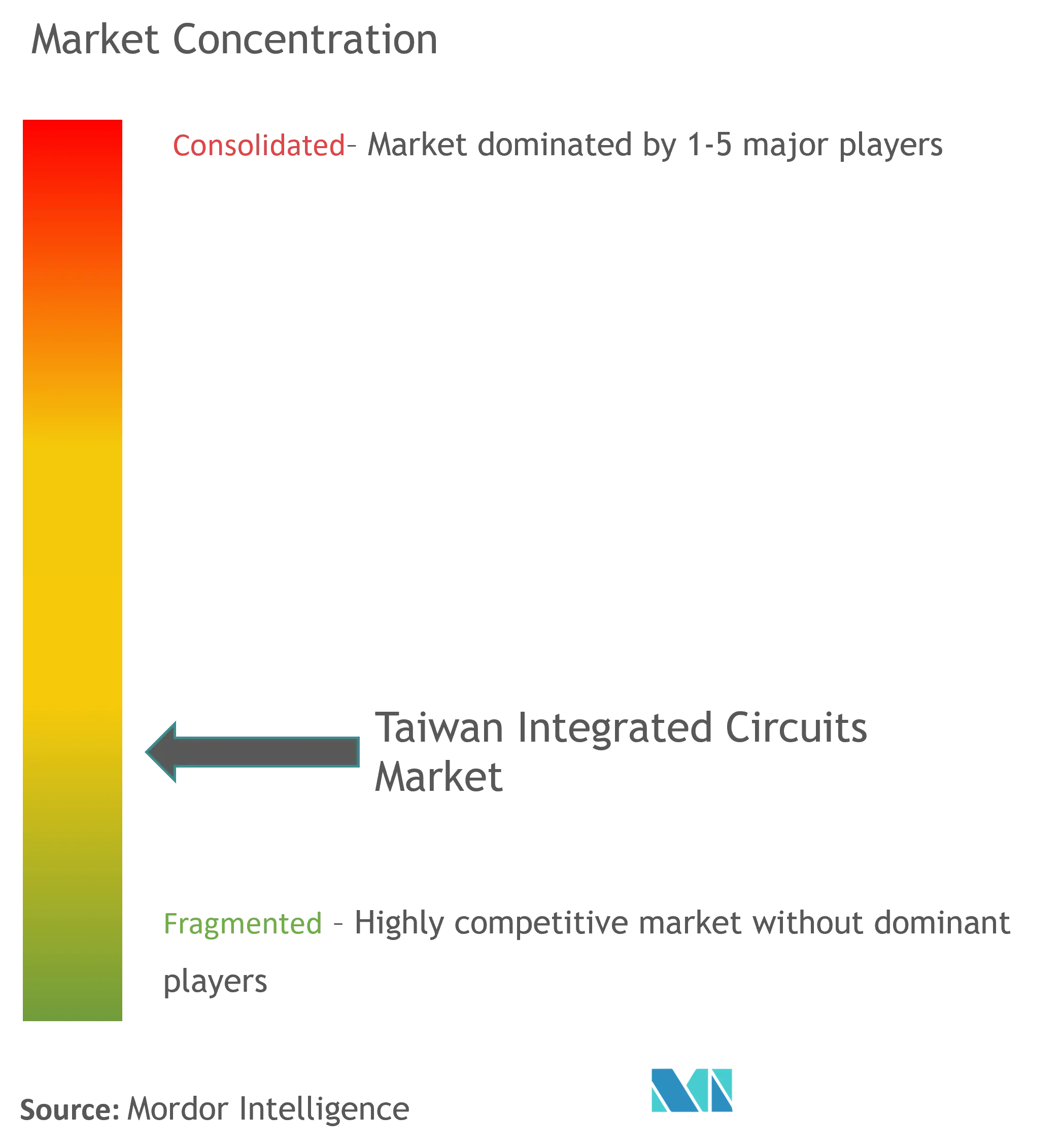
Taiwan Integrated Circuits Market News
- December 2023 - Asahi Kasei Microdevices Corporation unveiled its AK7018 and AK7017 audio DSPs with dual and single HiFi 4 CPUs, respectively, both pin-compatible. These new additions to the AK701x series aim to elevate the in-car audio and voice experience. In a strategic move, AKM collaborated with DSP Concepts, Inc., enabling the AK701x lineup to leverage the Audio Weaver platform. This collaboration fosters a versatile and expandable audio and voice application development environment and taps into the diverse array of 3rd party audio algorithms already available on Audio Weaver.
- December 2023 - Infineon unveiled its new PSoCEdge series of microcontrollers, featuring an integration of the Arm Cortex-M55 core with Helium DSP and the Ethos U55 NPU unit, specifically designed for advanced AI operations. Complementing this, the microcontroller also boasts a power-efficient Arm Cortex-M33 core, coupled with an NNLite(DSP/NPU) tailored for less complex AI functions. This dual-core configuration enhances the device's efficiency across a spectrum of workloads.
Taiwan Integrated Circuits Market Report - Table of Contents
1. INTRODUCTION
- 1.1 Study Assumptions and Market Definition
- 1.2 Scope of the Study
2. RESEARCH METHODOLOGY
3. EXECUTIVE SUMMARY
4. MARKET INSIGHTS
- 4.1 Market Overview
-
4.2 Industry Attractiveness - Porter's Five Forces Analysis
- 4.2.1 Bargaining Power of Suppliers
- 4.2.2 Bargaining Power of Consumers
- 4.2.3 Threat of New Entrants
- 4.2.4 Threat of Substitute Products
- 4.2.5 Intensity of Competitive Rivalry
- 4.3 Industry Value Chain Analysis
- 4.4 Impact of COVID-19 Aftereffects and Other Macroeconomic Factors on the Market
5. MARKET DYNAMICS
-
5.1 Market Drivers
- 5.1.1 Increasing Penetration of Smartphones, Tablets and Consumer Electronics
- 5.1.2 Rising Capital Spending by Fabs to Increase Production Capacities
-
5.2 Market Restraint
- 5.2.1 Complex Fabrication Process owing to the Decreasing Chip Size
6. MARKET SEGMENTATION
-
6.1 By Type
- 6.1.1 Analog IC
- 6.1.2 Logic IC
- 6.1.3 Memory
- 6.1.4 Micro
- 6.1.4.1 Microprocessors (MPU)
- 6.1.4.2 Microcontrollers (MCU)
-
6.2 By End-user Industry
- 6.2.1 Consumer Electronics
- 6.2.2 Automotive
- 6.2.3 IT & Telecommunications
- 6.2.4 Manufacturing & Automation
- 6.2.5 Other End-user Industries (Healthcare, Aerospace & Defense, etc.)
7. COMPETITIVE LANDSCAPE
-
7.1 Company Profiles*
- 7.1.1 Intel Corporation
- 7.1.2 Texas Instruments Inc.
- 7.1.3 Analog Devices Inc.
- 7.1.4 Infineon Technologies AG
- 7.1.5 STMicroelectronics NV
- 7.1.6 NXP Semiconductors NV
- 7.1.7 On Semiconductor Corporation
- 7.1.8 Microchip Technology Inc.
- 7.1.9 Renesas Electronics Corporation
- 7.1.10 Samsung Electronics Co. Ltd
- 7.1.11 SK Hynix Inc.
8. INVESTMENT ANALYSIS
9. FUTURE OF THE MARKET
** Subject To AvailablityTaiwan Integrated Circuits Industry Segmentation
Integrated circuits (ICs) are compact electronic devices that integrate multiple components, such as transistors, resistors, capacitors, and diodes—onto a single piece of semiconductor material, typically silicon. This integration facilitates the creation of complex circuits capable of performing various functions within a small physical footprint.
For market estimation, the revenue generated from sales of various types of integrated circuits used in various industries, such as consumer electronics, automotive, IT and telecommunication, manufacturing, and automation, across Taiwan is being tracked. The market trends are evaluated by analyzing the investments made in product innovation, diversification, and expansion.
The Taiwan integrated circuits market is segmented by type (analog IC, logic IC, memory, and micro [microprocessor, microcontrollers, and digital signal processors]) and end-user industry (consumer electronics, automotive, IT & telecommunications, manufacturing & automation, and Other end-user industries). The market sizes and forecasts are provided in terms of value (USD) for all the above segments.
| By Type | Analog IC | |
| Logic IC | ||
| Memory | ||
| Micro | Microprocessors (MPU) | |
| Microcontrollers (MCU) | ||
| By End-user Industry | Consumer Electronics | |
| Automotive | ||
| IT & Telecommunications | ||
| Manufacturing & Automation | ||
| Other End-user Industries (Healthcare, Aerospace & Defense, etc.) |
Taiwan Integrated Circuits Market Research FAQs
How big is the Taiwan Integrated Circuits Market?
The Taiwan Integrated Circuits Market size is expected to reach USD 28.35 billion in 2024 and grow at a CAGR of 9.24% to reach USD 44.11 billion by 2029.
What is the current Taiwan Integrated Circuits Market size?
In 2024, the Taiwan Integrated Circuits Market size is expected to reach USD 28.35 billion.
Who are the key players in Taiwan Integrated Circuits Market?
STMicroelectronics N.V., NXP Semiconductors N.V., Intel Corporation, Samsung Electronics Co Ltd and SK Hynix Inc. are the major companies operating in the Taiwan Integrated Circuits Market.
What years does this Taiwan Integrated Circuits Market cover, and what was the market size in 2023?
In 2023, the Taiwan Integrated Circuits Market size was estimated at USD 25.73 billion. The report covers the Taiwan Integrated Circuits Market historical market size for years: 2018, 2019, 2020, 2021, 2022 and 2023. The report also forecasts the Taiwan Integrated Circuits Market size for years: 2024, 2025, 2026, 2027, 2028 and 2029.
Taiwan Integrated Circuits Industry Report
Statistics for the 2024 Taiwan Integrated Circuits market share, size and revenue growth rate, created by Mordor Intelligence™ Industry Reports. Taiwan Integrated Circuits analysis includes a market forecast outlook for 2024 to 2029 and historical overview. Get a sample of this industry analysis as a free report PDF download.



